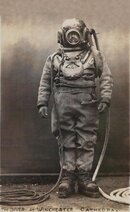Does anyone have any comments or justifications why it is still in the training manuals or does it just keep slipping through because it has always been done that way and agencies don't want to move with the times(heaven forbid!).
I think it's important on all fronts to continually ask the question if it's necessary or not or if it's a 5 monkeys thing.
My first impulse would be to answer your question with another question. If your child were engaged in a water sport do you think they should be able to swim?
To me it's a red-flag issue when people come to lessons and they can't already swim. If someone has so little affinity for being around water then why would they want to learn how to scuba dive?
R..




